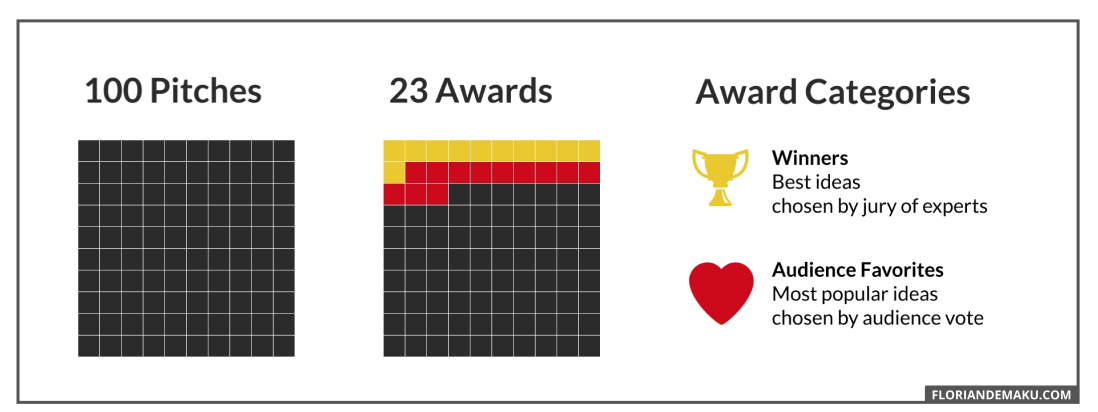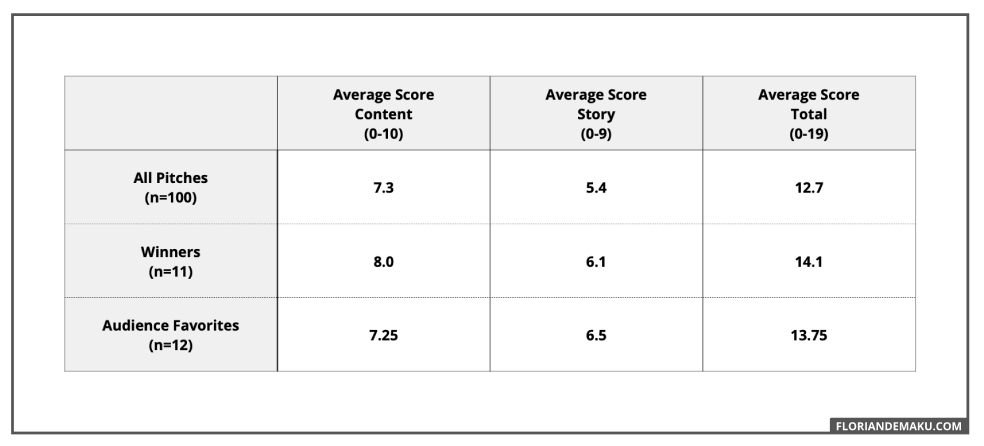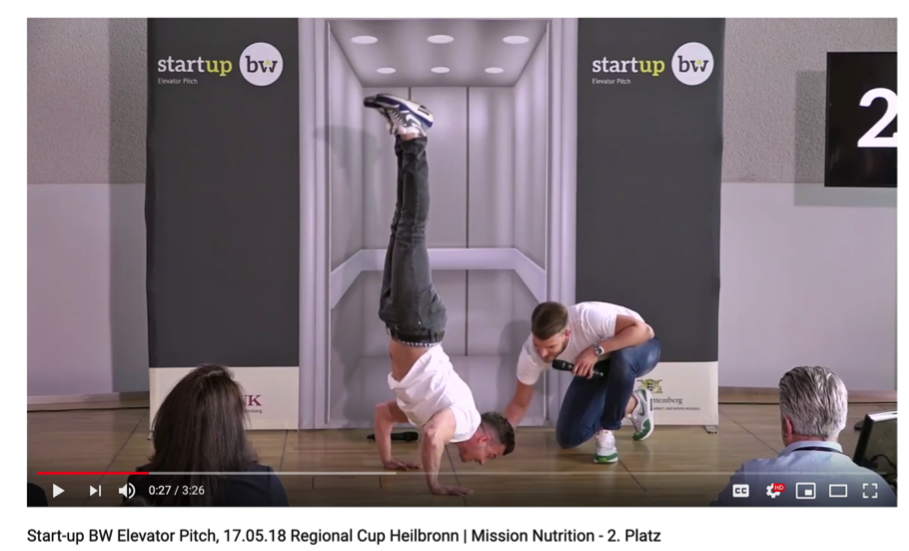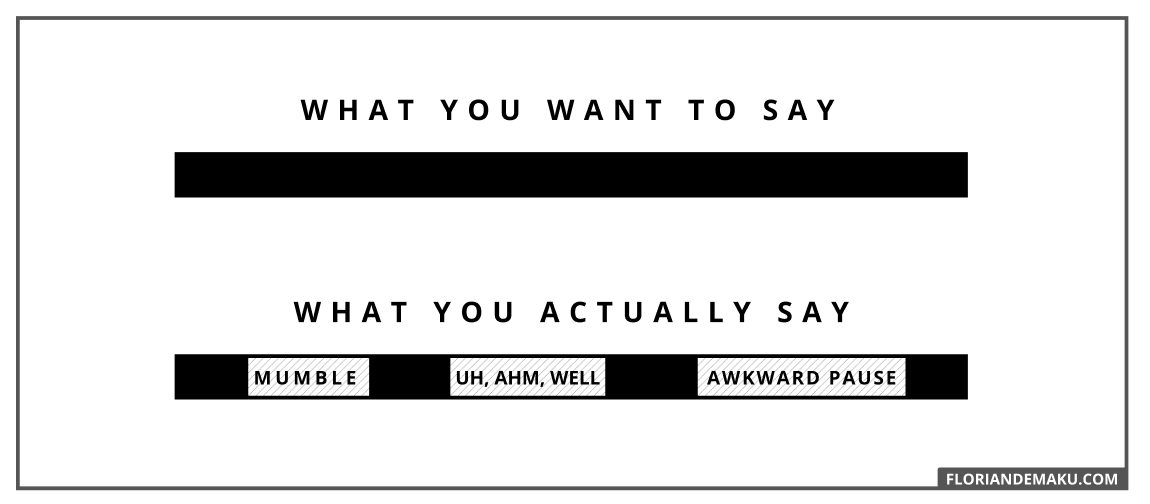I analyzed 100 Pitches on Video - Here's what I learned
I break down 100 Pitches to find out what makes pitches successful. The findings will help you to craft great pitches that sell your idea, convince your audience and make an impact!
1. Bad pitches ruin great ideas - and that's a shame
A challenge founders face is pitching their ideas. Pitching is a daunting experience. You step up on stage and your work gets tested.
Many great ideas die right there. Murdered by bad performance, never coming to fruition. Great potential buried beneath a bad pitch.

I see especially tech people struggling here. They come up with good ideas. They figure out all the details. They use technology in spectacular ways. And then they fail at communicating their idea.
And all their nerdgasm-inducing brilliance doesn't translate. Instead, they leave an impression of nerds too far out. Too caught up in tech-stuff to follow basic social and business rules.
As a fellow tech person, this is devastating to witness. Solid ideas get lost this way.
The best ideas do not win
In a perfect world, the best idea would win. But our world is not perfect. In fact, our daily life is full of mediocre ideas. History is full of great ideas that never received support.
The best ideas do not win. The ideas that get the most support do.
As a founder getting that support is your job. Pitching your idea is a practical way to do that. Pitching thus is an essential skill founders, innovators and change-makers need.
It's easy to judge whether a pitch is good or bad in hindsight. But our first reaction to a pitch is intuitive and subjective. To find out what makes pitches better, we need reliable and objective results.
What exactly makes a good pitch? Is it content? Is it story? Is it the founder's personality? What influences audience approval most?
I looked at 100 pitches to find answers.
2. Let's "measure" the quality of a pitch
First, we need a practical way to break a pitch into smaller blocks. Then we can compare across pitches and see which parts are essential for success.
I break down every pitch into two categories: content and story.
The content score measures how much hard information there is in the pitch. Hard facts are information about the problem, solution, market, and the founder's plans. As foundation I used the main points from 10 slides you need in your pitch by Guy Kawasaki.
The story score determines how many storytelling elements are in the pitch. Storytelling elements are things like sharing personal experiences or painting a future vision.
For inspiration I borrowed from two classics. Joseph Campbell's hero's journey and Freytag's narrative Pyramid. I also added the modern Storytelling Canvas by Christoph Kayser.
The final framework I ended up with looked like this:

It rates every pitch on a scale from 0-10 for content and 0-9 for storytelling. The best result a pitch can score are 19 points in total.
When an element out of these lists shows up in the pitch, the corresponding category scores a point. The framework thus counts which elements are part of the pitch. It does NOT account for the quality of the single points!
This framework analyzes all 100 pitches.
3. The Data Sample
I took 100 pitches from a local idea competition called “Startup BW Elevator Pitch”. It's a public pitch competition in southwest Germany. It consists of several local events all over the state. It ends with a round of finals where all local winners compete again.
These pitches make a good dataset, because they all follow the same rules:
- Pitch can't be longer than 3 minutes.
- Just the pitch - no questions and clarifications afterwards.
- No digital slides, only physical props allowed.
- Ideas are early stage and not limited to a specific field.
Teams can win two types of prizes:
- The most promising ideas are the “winners”.
They get chosen by a jury of local investors and VCs. Winners get awarded 500€ prize money and move on to the finals. - The most popular ideas are the "audience favorites".
They get chosen by the audience at the event and win 200 €.

All 100 pitches are available to look at on YouTube (in German only).
4. What the data shows
After crunching the numbers, the results look like this:

What the analysis shows:
- Winners outperform the average on content (8.0 > 7.3) and story (6.1 > 5.4).
- Audience favorites outperform the average in story (6.5 > 5.4) and also the winners (6.5 > 6.1). They do worse on content (7.25 < 7.3) than the average though.
- It's easier to predict winners by looking at the content than by looking at story.
- There is no significant correlation between content and story score. Teams that do well with content do not tend to do better on story.
The data revealed two more interesting points:
- A high content score does not make you a winner. But a low content score makes it almost impossible to win.
- Pitches with major problems in delivery did not win at all. Major problems are losing track or exceeding the time limit.
Interpretation points to two major conclusions
The following two statements are true for the majority of the data:
- The expert jury cares foremost about hard facts, content and quality of ideas.
- The audience favors a good story and is more forgiving with gaps in the content.
Here are two pitches that exemplify these statements:
Winner: WiMedical (Content 7, Story 1)

This pitch is an outlier: It's the winner with the lowest story score among winners. It has an average content score (7 out of 10) but almost no story points (1 of 9).
The founder talks about his innovative medical product. His idea is already patented. The pitch is a long list of facts. It describes the product and it's advantages over the competition. It ends with a solid go-to-market strategy.
Even without a great story, this convinces the jury.
Audience Favorite: Mission Nutrition (Content 6, Story 9)

This pitch is a typical audience winner. It scores 6 on content (below average) but does great on story (9).
The founders market a nutrition product aimed at the fitness segment. Their pitch has outstanding delivery: Lots of humor, surprises and very impressive acrobatics.
This fits the fitness segment and makes for a great show that the audience loves. A clear audience favorite - despite small gaps in the content.
5. What we can learn from this
Ordered by importance for winning, here are the major learnings:
5.1 Avoid mistakes in your delivery
Before you can get the details right you must make sure that no major things go wrong!
Teams struggle with two big mistakes here:
- Going over the time limit.
The deadliest mistake teams make is overextending the 3-minute time limit. None of the teams that disregards the timing and gets cut off wins any price. - Losing track during the pitch.
Same goes for teams who lose track during their presentation. People who memorize their full pitch are at high risk here!
Minor hiccups and having to think for a bit is fine and natural. You don't have to be a rhetorical genius to win. You don't need a charismatic showmaster-personality to charm the audience. But you need to keep a steady flow without major interruptions or hang-ups.

Problems with delivery are a sign of sloppy preparation. Your audience dislikes when you aren't making a proper effort. Thus make sure your preparation is on point. A good rule of thumb here is:
Put in at least one hour of preparation for each minute of your pitch.
Comedians and similar artits are useful role models. They rehearse a lot to make their delivery seems effortless and easy on stage.

If you want to win, make sure you can deliver your pitch!
5.2 If your content is weak you will fail
Your content is the sum of explanations, facts and information you present about your idea. Content convinces the rational reasoning of your listeners. The data shows that winning without solid content is almost impossible.
There is no excuse for not getting content right.
This is crucial when pitching to investors, VC’s or business angels. These people poke holes into business ideas for a living. They will spot gaps in your content, too. Your goal is to leave as few gaps as possible.

Here are some basics for strong content:
- Make sure your pitch covers all aspects of your idea
Typical startup pitches have building blocks that audiences expect. Guy Kawasakis Framework can guide you. Use simple wording that everybody understands. Being understood beats sounding fancy - especially when talking about tech. - Use data to make your claims invincible
Facts, data and research are the pillars of your reasoning. Any credible outside proof can help make these pillars stronger. Solid and proven your content makes it easier to speak with confidence. Your audience will intuitively pick up on this. - Focus on what makes your idea stand out
Time in a pitch is short. Be picky about where you go into detail. Don't waste time explaining obvious no-brainers. Instead, emphasize points that are unique about your idea, your thinking or your team. These are most likely to stick with your audience. - Be honest about your blind spots
It's fine to not have everything figured in the beginning. But the way you handle this is important. Be honest and proactive about valid weak spots. Admitting you have some work to do will serve you better than bullshitting, lying or covering it up.
To get these four points right pitch often and to lots of people. People who aren't familiar with your idea can give you valuable insights. Use their questions and doubts to fine-tune your content.
5.3 Storytelling gives you another fist to punch with
Story is the sum of narration, personal anecdotes and visionary outlooks in your pitch. Stories put the hard facts into the context of human experience. This engages the emotional side of your audience. Among teams with similar content score, story becomes the differentiator.
Your story is what will make you stand out.
A good story engages your listeners in ways your content can't. Your story alone thus has great value. It can make up for weaker parts in your content. But the real magic happens, when solid content meets great storytelling. The most loved pitches combine solid content with great storytelling.
To convince lots of people, you need to have a story that they can buy into.
Careful:
Storytelling doesn't mean that your pitch has to be a legendary fantasy epic. You don't need to make up things. Instead, think of storytelling as the glue that connects the hard facts with you as a person.

Here are some ways to add storytelling to your pitch:
1. Make it personal
Present the facts through the lens of your experiences. How do you think about your idea? What past events got you started? Why are you the right person to work on it? Be authentic. Spell out what excites you. Sweep us along with your enthusiasm!
2. Create a vision of the future thats mindblowing
Ideas are exciting because of their future potential. Your vision is what brings this potential to life. What will your idea be like one/three/five years from now? How will it look and feel? What will be better compared to today? Walk us through the impressive future that exists in your imagination. If that vision is appealing, people will support it.
3. Find a shared greater cause and connect through it
Give your audience the opportunity to connect through shared beliefs, causes and values. Ask yourself: Why do you care? What beliefs motivate you? What impact do you want to make? How will the world be better with your idea? Show that your idea helps solving a bigger problem. This makes it easy for people who care about the bigger problem to support your idea.
4. Realize that a pitch is also a show
In a pitch it’s fair to look beyond facts and reality. It’s okay to add vision and dreaming to the mix. It's fine to focus on your ideas sexiest parts. Polishing is good as long as you stay truthful. Keep in mind: The goal is to win trust. Lying and deception are trust killers.
Getting your story right will take some experimenting. Aim to be personal, authentic and vulnerable. Try different approaches until you feel comfortable telling your story. Again, pitching to a lot of people can give you valuable feedback on what story works for you and your idea.
If you want to excel at presenting, you need at least a basic understanding of storytelling.
6. Summary

- Avoid mistakes in your delivery.
Practice until your delivery is clear, confident and on time. Then practice some more! - Solid content will convince minds
You need to meet your audiences desire for content, plausibility, logic and reason. You do this by making sure your content is on point.
Get feedback from people not familiar with your idea, until there are no more gaps in your content. - Your Personal story will win their hearts
You also want to get your audiences emotional support to get them to root for you and your idea.
You achieve this trough storytelling. Share your experiences and perspective and make us feel the epic future you are working on
It’s not either content or story that makes your pitch good. Rather, storytelling and content serve different purposes and your pitch needs both.
Put in simple formula:
Make sure you can deliver with ease and confidence. Convince their minds with reason and data. Win their hearts over with story and emotion.
Now go forth and fear no darkness ace those pitches!
Images and Icons used:
- Photo by Austin Distel from (www.useproof.com) on Unsplash
- Icons made by Freepik on www.Flaticon.com
- Clipsarts taken from Clipartlibrary.com: Microphone and Tombstone
